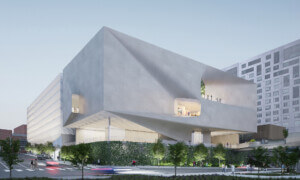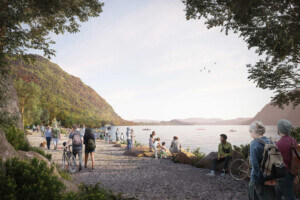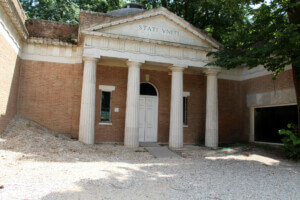More details were announced Monday about the upcoming U.S. Pavilion at the 2018 Venice Architecture Biennale. The exhibition will be titled Dimensions of Citizenship and curated by Niall Atkinson, associate professor of architectural history at the University of Chicago; Ann Lui, assistant professor at the School of the Art Institute of Chicago (SAIC); Mimi Zeiger, an independent critic, editor, curator, and educator; and associate curator Iker Gil, lecturer at SAIC.
Dimensions of Citizenship will feature the work of seven architecture practices to “explore how citizenship may be defined, constructed, enacted, contested, or expressed in the built environment at seven different spatial scales. Expanding from the body and city to the network and the heavens, the seven installations raise questions about issues including belonging, sovereignty, and ecology,” according to the curatorial statement.
The seven spatial scales are used as an organizing principle to examine the ways citizenship affects and is affected by the built environment. Each studio is assigned a scale as the prompt.

Scale: Citizen / Amanda Williams + Andres L. Hernandez, in collaboration with Shani Crowe
From the project description: “Dimensions of Citizenship begins at the scale of the citizen with the project Thrival Geographies (In My Mind I See a Line), which will consider how race shapes notions of identity, shelter, and public space in historically African-American communities. For their installation in the courtyard of the U.S. Pavilion, Williams (a recently named 2018 USA Ford Fellow) and Hernandez, who is an associate professor of art education at SAIC, will partner with Chicago-based artist Shani Crowe, whose intricate braided hair sculptures have been worn by celebrities such as Solange. While the specter of slavery and continued racial injustice will be at the core of the installation, the piece will ultimately strive for a possible architecture of freedom that might allow all citizens to thrive and participate in the democratic ideal.
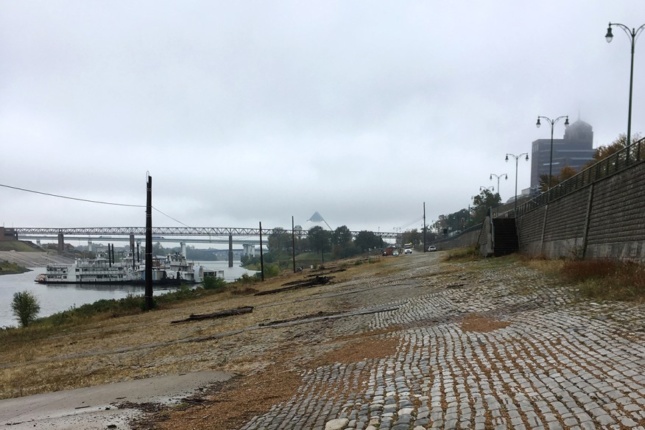
Scale: Civitas / Studio Gang
From the project description: “Led by 2011 MacArthur Fellow Jeanne Gang, Studio Gang uses design as a medium to help strengthen communities. Stone Stories builds on the Studio’s ongoing work in Memphis, Tennessee, to investigate how redesigning cities’ public space can be an exercise of citizenship and empowerment. Inspired by Memphis’s recent removal of two Confederate statues, Stone Storiesoffers an inclusive urban vision for Cobblestone Landing, an overlooked yet historically important site along the Mississippi River. Hundreds of Memphis cobblestones will be shipped to Venice and used as a platform to share the stories of Memphians past and present, offering visitors a visceral and material interaction with a distant public space and the citizens who are actively building its shared urban future.”

Scale: Region / SCAPE
From the project description: “SCAPE, under the leadership of 2017 MacArthur Fellow Kate Orff, will demonstrate that landscape architecture can be a critical tool for re-envisioning the response of citizens to climate change. SCAPE’s project, Ecological Citizens, understands the region as an area defined by the shifting relationships of ecology, infrastructure, and climate. It takes the Venetian Lagoon as a globally significant case study of a tidal region under ecological threat. Partnering with Università di Bologna and the Italian Institute of Marine Sciences, SCAPE will present possible solutions or interventions to aid the environmentally sensitive La Certosa island in the lagoon.
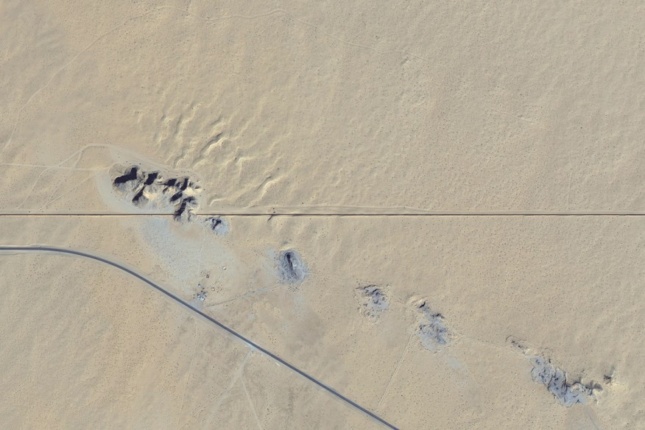
Scale: Nation / Estudio Teddy Cruz + Fonna Forman
From the project description: “Estudio Teddy Cruz + Fonna Forman challenges the way we think about national boundaries. Their project, MEXUS: A Geography of Interdependence, reveals a transnational zone comprised of eight watershed systems shared by Mexico and the United States. MEXUS provokes us to rethink citizenship beyond the limits of the nation, mobilizing a more inclusive, interdependent idea based on co-existence, shared assets, and cooperative opportunities between divided communities. Cruz is the winner of the 2018 Vilcek Prize in Architecture, which is presented to immigrants who are champions of the arts and sciences.

Scale: Globe / Diller Scofidio + Renfro, Laura Kurgan, Robert Gerard Pietrusko with Columbia Center for Spatial Research
From the project description: “When we zoom out to the scale of the globe, the primacy of the individual, the city, and even the nation drops away and is replaced by data: electricity, trade routes, migratory shifts, and the flow of capital, goods, and people. In Plain Sight—a collaboration among Diller Scofidio + Renfro, Laura Kurgan, and Robert Gerard Pietrusko with Columbia Center for Spatial Research—uses data drawn from images created by the Soumi National Polar-orbiting Partnership satellite to visualize where people live on earth. Two contrasting NASA images of the Earth taken at 1:30 pm and 1:30 amshow us the gaps in the network: the places with many people and no lights, and those with bright lights and no people. This information maps out a political geography of belonging and exclusion.
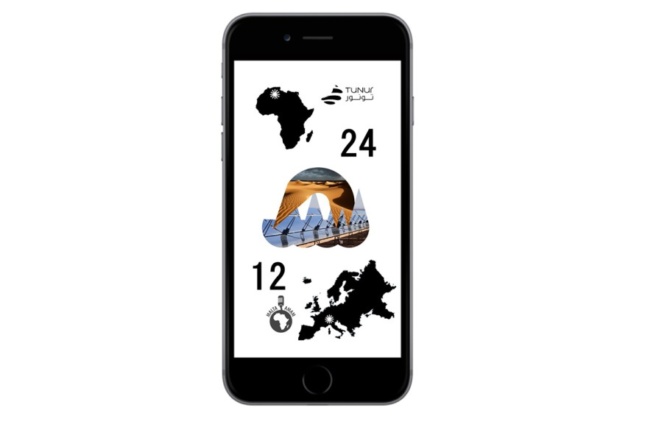
Scale: Network / Keller Easterling with MANY
From the project description: “Keller Easterling’s writings and projects regularly investigate the emergent territory where the state meets the digital network. With MANY, an online platform designed to facilitate migration through an exchange of needs, Easterling and team propose that we use the network to rethink possibly outdated notions of citizenship. With a nod to the pervasive and familiar share economies that define online life, MANY envisions a global form of matchmaking between the sidelined talents of migrating populations and the multitude of opportunities around the world. Favoring cosmopolitan mobility over national identity, MANY looks to short-term visas as a tool to foster an exchange of needs.
![Planetary Ark [1/3] (All Aboard) the Architekton (2018), Design Earth. From: Cosmorama, Design Earth. (Courtesy Design Earth)](/wp-content/uploads/2018/03/Design-Earth-Planetary-Ark-645x645.jpg)
From the project description: “The space above Earth, as a site of existing human occupation and potential belonging, has become a territory that both captures the imagination and serves as a theater for existing conflicts or conditions. In looking to the cosmos, Design Earth’s speculative designs suggest possible off-world architectural responses. Design Earth’s El Hadi Jazairy and Rania Ghosn (recipient of the 2017 Boghossian Foundation Prize) present three “geo-stories,” which speculate on the legal geography of citizenship when extended to “the province of all mankind.” Together the stories in Cosmorama—Mining the Sky, Planetary Ark, and Pacific Cemetery—ask how we should reckon with the epic and frontier narratives that have fueled space exploration, at a time when prospects of instability and extinction have become normal on Earth.








